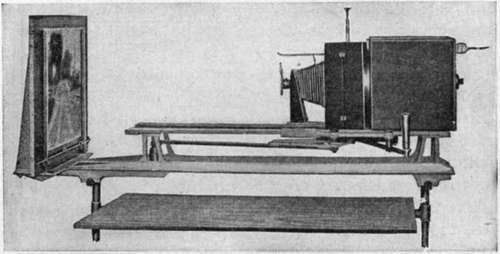Enlarging
Description
This section is from the book "Airplane Photography", by Herbert E. Ives. Also available from Amazon: Airplane photography.
Enlarging
In the French service contact printing was the rule during the war. The English practice, on the other hand, was to take small negatives—4X5 inches, with 8 to 12 inch lenses—and enlarge them, usually to 6^X8^ inches. For this purpose a regular part of the English photo section equipment was the enlarging camera (Fig. 115). This may be briefly described as a short focus camera in which the subject to be photographed is a negative, illuminated by transmitted light, whose image is thrown by the camera lens on the paper or other sensitive surface. By making the distance between negative and lens less than that between lens and paper, the resulting print is an enlargement, and vice versa. The scale of enlargement or of reduction is varied over limits set only by the length of the camera and the amount of light available.
The lens employed must of course possess sufficiently high quality to preserve all the sharpness of the negative, and focussing must be done with accuracy. Next to the lens the most important element is the light source. This may be of the point form, such as a concentrated filament electric lamp, an oxy-acetylene lime light, or an acetylene flame. The latter was extensively used in the English service, while acetylene generators for emergency purposes formed part of each American photo truck equipment. With point light sources we must use condensers to focus the light into the projecting lens. Much less efficient, but the only recourse where large condensers are not available, is a diffusing glass behind the negative, illuminated either by a bank of electric lamps with mirrors or by a U tube mercury vapor lamp, where proper current can be got.
The device for holding the printing paper must permit quick changing, but insure good contact. We may use either a spring plate to hold the paper against plate glass from behind, or else a weight acting on a lever arm of sufficient length.
The need for some automatic means of focussing an enlarging camera has been very generally felt. An illustration of such an enlarging camera is that put out by Williams, Brown & Earle, of Philadelphia, known as the "Semper-focal" (Fig. 121). In this camera the movements of the lens, paper easel and negative are so inter-related and actuated setting of the camera may be found by either of two methods: the negative may be previously scaled and marked with a line on its edge, which must be projected to a definite size; or the true location of several points in the picture as obtained from an accurate map may be marked on the enlarging camera easel according to the desired scale, and the negative image projected to coincide with these. In either case, if an exact scale is desired, allowance must be made for paper shrinkage, a matter which must be determined by previous experiment with respect to each other that the correct focus of the instrument is maintained for any degree of enlargement or reduction. This feature is a great help in making up mosaic maps, where prints of continuously varying scale ordinarily occasion serious delay for individual focussing.

Fig. 121. - "Semperfocal" enlarging camera, with mechanism for holding image in focus at any enlargement.
Determining the correct enlargement for each negative of a mosaic is perhaps the most important problem in the use of the enlarging camera for aerial work. The correct:
Continue to:
- prev: Stereo Printing
- Table of Contents
- next: Rectifying
Tags
camera, lens, airplane, aerial, film, exposure, photography, maps, birdseye
